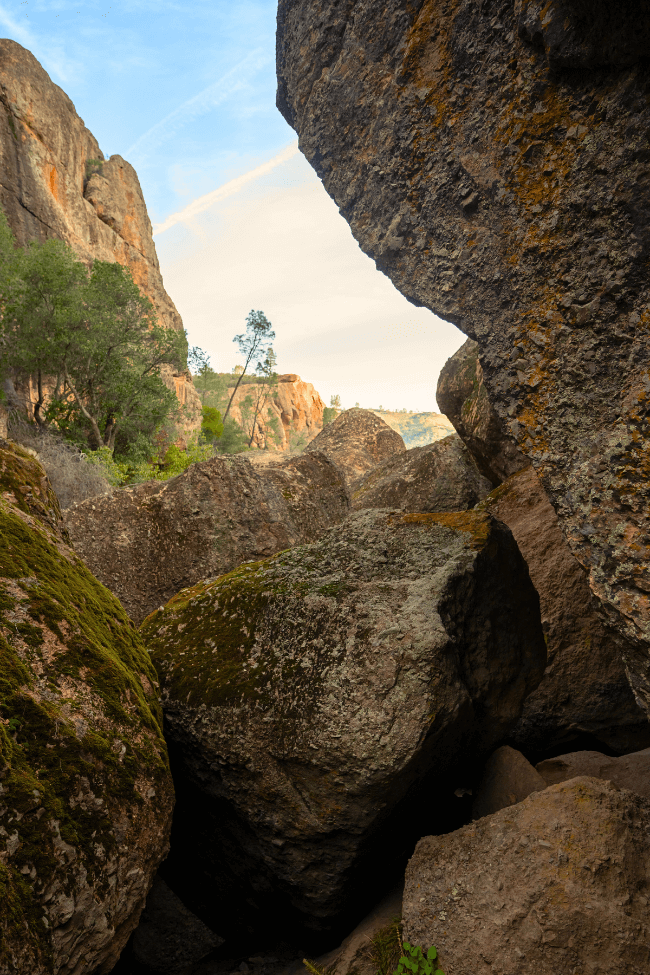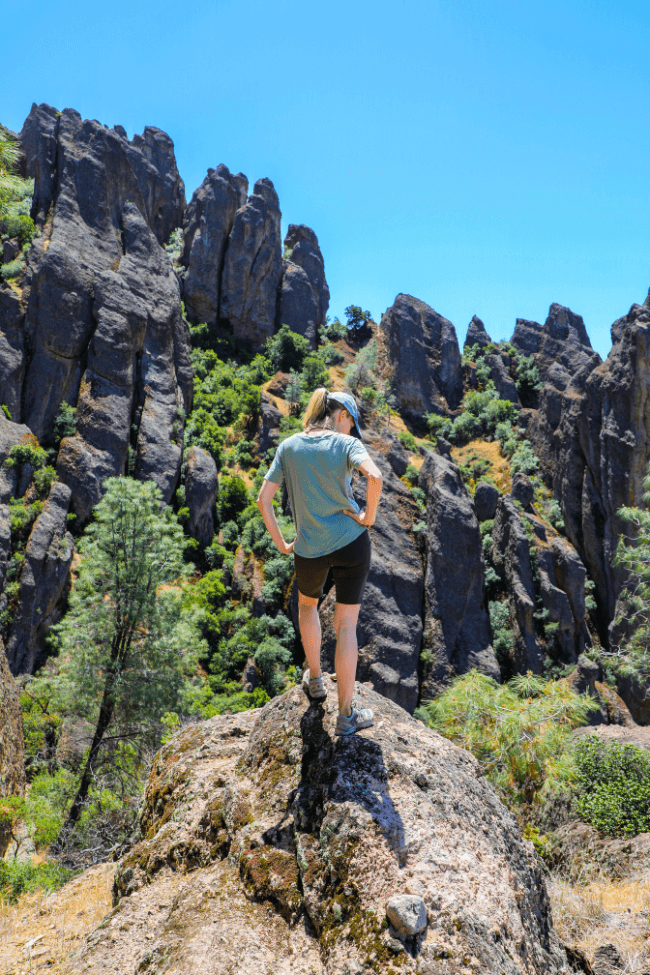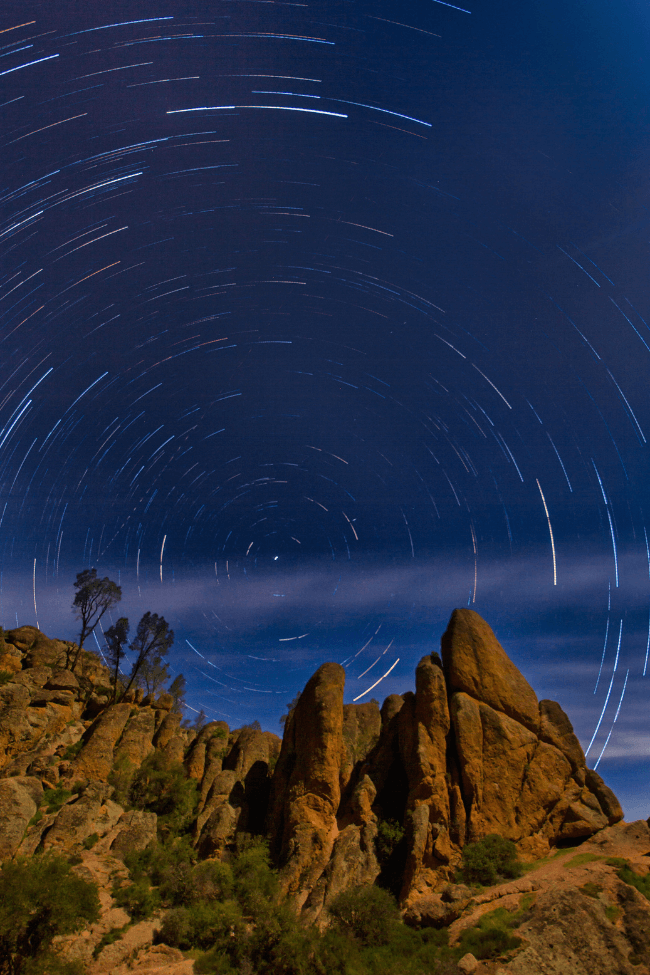Tucked away in the rolling hills of Central California, Pinnacles National Park is a mesmerizing landscape, sculpted by volcanic activity and shaped by the forces of nature.
Pinnacles is the smallest and the newest national park in California, so there’s not as much information out there as there is with some other national parks.
It’s one of the most underrated national parks in California and it’s also the least visited national park.
But it has a LOT to offer…
- Explore the unique volcanic formations of Pinnacles National Park.
- Discover the mysterious talus caves and Townsend’s big-eared bats.
- Witness the majestic flight of the rare and endangered California Condors.
- Embrace the adventure on numerous hiking trails and rock climbing spots.
- Stargaze and take part in astrophotography
Use the table of contents just below to skip to the bit that interests you the most (it expands if you click on it)…
Essential Visitor Information
Let’s start off with some housekeeping so you don’t end up in Yosemite by accident.
How To Get There
The park’s east and west entrances are not connected by a through road.
Travel between them typically involves a detour via King City on Hwy 101.
Use these coordinates to avoid getting lost:
- East Side (Pinnacles Visitor Center): 36.493545, -121.146646
- West Side (Pinnacles Visitor Contact Station): 36.477700, -121.226136
Driving Directions
From the North (San Francisco Bay Area):
- To East Entrance: Take Hwy 101 south, switch to Hwy 25 south after Gilroy.
Pass Hollister, continue for 30 miles, then turn right onto Hwy 146 and left into Pinnacles Campground. - To West Entrance: Take Hwy 101 south to Soledad, then Hwy 146 east.
Follow the one-lane road for 14 miles into the park.
From the South:
- To East Entrance: On Hwy 101 north, exit at King City’s 1st Street, continue straight as it becomes Bitterwater Rd.
After intersecting Hwy 25, turn left and drive ~15 miles, then left onto Hwy 146. - To West Entrance: Take Hwy 101 north to Soledad, then Hwy 146 east.
The road becomes one lane; proceed with caution for 14 miles to the park.
Remember, the Bear Gulch Area is an additional 3.5 miles from Pinnacles Campground along Hwy 146.

Getting In
There is an entrance fee that you have to pay and it applies year-round excluding some special days.
- If you arrive by foot or bicycle – $15.00
- Motorcycle/scooter – $25.00
- Private Vehicle – $30.00 (includes everyone in the vehicle)
Some fee-free days happen every year coinciding with some public holiday dates.
Find the most updated information on fees at the following link:
Maps and Information:
Obtain park maps and information at the visitor’s center to navigate easily.
Alternatively, check out the National Park Service website to see them beforehand.
Transportation:
While there’s no public transport within the park, the main attractions are accessible by car or by taking the hiking trails.
Dining Options
While the park doesn’t house restaurants, the east side visitors center offers basic food options.
Alternatively, pack a picnic to enjoy amidst nature with food that you already know you’ll like.
For nearby towns/cities:
- Hollister is your best bet if you’re going from the east entrance.
- Soledad or Salinas are the best options if you’re leaving from the west entrance.
Best Times To Visit
Visiting Pinnacles National Park is an experience that varies with the seasons.
Each brings its own unique beauty and challenges.
Spring: A Colorful Tapestry
Spring, from March to May, is perhaps the most magical time at the park.
The weather is pleasant, making it ideal for hiking and wildlife spotting.
The park is alive with vibrant wildflowers, painting the landscape in a spectrum of colors.
Spring (along with fall) is one of the best times to see condors too.

Summer: Sun-Kissed and Lively
Summer brings warmer weather, perfect for early morning hikes or late evening strolls.
But it can get uncomfortably hot so be prepared for higher temperatures and bring plenty of water.
It’s a great time to enjoy the less crowded trails and the park’s diverse flora and fauna.
Fall: Serene and Picturesque
Autumn, with its mild temperatures and fewer visitors, offers a tranquil escape.
The changing colors of the foliage add a serene beauty to the park, making it a photographer’s haven.
Like spring, this is also a good time to spot the California Condor.
Winter: Cool and Calm
Winter in Pinnacles is cooler and quieter.
It’s a time for peaceful hikes, with the possibility of rain adding to the park’s mystique.
Pack layers to stay comfortable during your exploration.
Overall not the best time to go though.
How Many Days Should I Spend?
For most people, 2 days is a perfect amount of time where you’d spend 1 day in the east side of Pinnacles and 1 day on the west side.
If you want to take it a bit slower then go for 3 days.
If you only have 1 day to spend then I’d recommend the east side of the park which has more facilities and access to more trailheads.
Accommodation & Camping
Whether you’re looking for a night under the stars or a comfortable bed nearby, Pinnacles National Park offers several options.
Camping Inside the Park: Pinnacles Campground
Pinnacles Campground, located on the east side, is the only in-park camping option.
It offers sites for tents, RVs, and group camping.
Though basic, it’s equipped with essential amenities for a comfortable stay.
Don’t forget to reserve your spot in advance!
You can reserve tent and RV sites up to 6 months in advance, and you can reserve group sites up to 12 months in advance.
You can reserve through recreation.gov.
Here’s a useful video that shows you what the camp site areas are like in Pinnacles.
Nearby Accommodations
For those preferring more traditional lodging, there are nearby cities such as Salinas, Soledad and Hollister.
While there’s not much in the way of luxury hotels, for those looking for basic options you could find something.
But it will mean you’ll have to drive a bit to get to the park every morning so camping at Pinnacles is probably a better option.
Overall, camping in the park is probably best if you want to stay more than 1 day.
Visitor Facilities & Amenities
The east side of the park is better equipped than the west side.
On the east side you’ll find:
- Pinnacles Visitor Center
- Bear Gulch Picnic Area
- Bear Gulch Nature Center
- East Pinnacles Book Store
- Pinnacles Campground
The west side mainly has picnic areas and parking lots with one visitor contact center.

Some of these places can be closed for periods of time so use the National Park Service website to help plan ahead.
Pinnacles National Park offers several well-maintained picnic areas, perfect for families and groups to enjoy a meal surrounded by nature.
In general restroom facilities are conveniently located near major picnic areas and trailheads throughout the park.
Use the maps we linked to earlier so you’re well prepared.
At the Pinnacles Visitor Center (east side) and the Bear Gulch Nature Center, you’ll find educational exhibits, park information, and staff to assist with any queries.
For those needing refreshments, the Pinnacles Visitor Center (east side) offers a small store with basic food items, beverages, and park merchandise.
Drinking water is available at both the east and west entrances of the park, but it’s advisable to carry your own water bottles to stay hydrated while exploring.
Please note, while the park is pet-friendly in specific areas like picnic spots and campgrounds, pets are not allowed on the trails or in the wilderness areas.
Connectivity
There is no cell phone service in the park.
WiFi is available for purchase at the East Pinnacles Visitor Center through the campground store.
Contact the park campground at 831-200-1722 for more information.
Things To Do At Pinnacles NP
Hiking & Outdoor Activities
Pinnacles National Park is a paradise for hikers and climbers.
With trails winding through stunning landscapes and rock faces beckoning climbers, there’s no shortage of outdoor activities.
The most popular trails include:
- High Peaks Trail
- Balconies Cave Trail
- Bear Gulch Trail
- Condor Gulch Trail
Insider tip! 💡
If you want to see a view of the Pinnacles’ High Peaks without going on a hike, you can drive up to the Chaparral trail head parking area (west side of park) and get a view from there.

High Peaks Trail: A Hiker’s Dream
The High Peaks Trail is the park’s crown jewel and you can reach it by entering from either side of the park.
It offers breathtaking views and a challenging terrain, making it a favorite among seasoned hikers.
The steep and narrow path, carved into the rock, leads to panoramic vistas of the park.
It’s a 6.5 mile loop with 1,800 feet elevation and it’s pretty strenuous, but you shoouldn’t need any special skills.
Go for the Balconies Cave Trail or Bear Gulch Trail for an shorter hike.
Bear Gulch Cave and Reservoir: A Peaceful Retreat
The Bear Gulch Cave, accessible from the east entrance, is a shorter but equally thrilling hike.
The length of the trail will vary depending on where you end up parking.
You could park at one of the following:
- Bear Gulch Day Use Area
- Moses Spring Parking Lot (closer to the start of the trail, but not many spots)
If you end up parking at the Bear Gulch Day Use Area it’ll be just over 2 miles round trip.
After exploring the cave, you can relax by the serene Bear Gulch Reservoir, a perfect spot for a peaceful break amidst nature.
For more information on this exact trail, this post is really helpful.
Also, note that the cave is closed sometimes to protect the bats so check the cave status here.
Condor Gulch Trail: Stepping Stone to the Peaks
The trail stretches approximately 1.7 miles one way, culminating near the Overlook, which is about 1.1 miles from the trailhead.
For a longer hike, many opt to continue to the High Peaks Trail, creating a loop of about 5.3-6 miles in total.
Parking:
Visitors can park at the Bear Gulch Day Use Area.
This area is accessible from the east entrance of the park, and the trailhead is just a short walk from the parking area.
Difficulty:
The Condor Gulch Trail is considered moderate to strenuous.
The first section of the trail involves a steep climb with an elevation gain of about 1,100 feet.
The path is well-maintained but can be challenging, especially during the hotter months.
Adequate water, sun protection, and sturdy footwear are recommended.
This trail is popular not just for its physical challenge but also for its breathtaking views of the Pinnacles rock formations.
You’ve also got the potential to spot the majestic California condors soaring overhead.
Balconies Cave Trail: An Adventure Awaits
From the west entrance, the Balconies Cave Trail is a must-visit.
This hike takes you to another spectacular talus cave.
Park at the Chaparral Trailhead and head off from there.
The journey through the cave is an exhilarating experience but check for cave closures before you set out.
Here’s a useful post going into more detail on it and here’s a video below that covers some of the trails from both sides of the park.
Wildlife in Pinnacles
Discover the diverse wildlife that thrives in the unique ecosystem of Pinnacles National Park.
The Majestic California Condors
Pinnacles has played an incredibly important role bringing back the California Condor from the brink and it is one of the release sites for these rare birds.
Best Spots for Condor Sightings:
The best spots to see the California Condor in Pinnacles is in the High Peaks area in the early morning or early evening.
Luckily you can get to this area from either entrance, but it does involve a fairly strenuous hike.
A Haven for Birdwatchers and Animal Lovers
In addition to the majestic California Condors, Pinnacles National Park is a sanctuary for a variety of wildlife and plants.
The park’s unique terrain supports a rich biodiversity, including over 140 bird species, 49 mammals, and 22 reptiles and amphibians.
Keep an eye out for the elusive bobcats, Townsend’s big-eared bats, and the vibrant western fence lizards.

Plants
As for plant life, the park is home to a myriad of native plants.
They range from towering gray pines and coast live oaks to an array of wildflowers like the delicate Mariposa lily and vibrant bush poppies, especially in the springtime.
Stargazing
Pinnacles National Park offers more than just hikes and rock climbing.
Pinnacles National Park, offers an extraordinary stargazing experience.
Its remote location and minimal light pollution create perfect conditions for observing the night sky.
Prime Stargazing Spots:
Pinnacles Campground:
Ideal for an overnight stargazing experience.
Here, the Milky Way often paints a brilliant trail across the sky.
Chalone Peak Trail:
Offers a higher elevation and clearer view, ideal for stargazers seeking a panoramic celestial display.
Bear Gulch Reservoir:
A serene spot where reflections of the stars shimmer on the water’s surface, adding to the magic of the night.

Celestial Events:
Meteor Showers:
The park is a fantastic location to witness meteor showers, with its wide, open skies providing an unobstructed view.
Photography
For photography enthusiasts, Pinnacles National Park transforms into a picturesque canvas, especially during the golden hours of sunrise and sunset.

Photographic Hotspots:
High Peaks at Sunrise:
Capture the first rays of light hitting the dramatic rock formations, creating a stunning contrast of shadows and light.
Balconies Cliffs at Sunset:
The setting sun bathes the cliffs in warm hues, creating a perfect backdrop for landscape photography.
Condor Gulch Overlook:
Offers breathtaking views of the Pinnacles, ideal for wide-angle landscape shots.
Astrophotography:
Don’t forget that Pinnacles National Park is an amazing place for astrophotography too since it is has low light pollution.
Understand The Geology of Pinnacles
The park’s namesake, the Pinnacles, are remnants of an ancient volcano.
These towering rock spires create a dramatic backdrop for adventurers and nature lovers alike.
The High Peaks Trail provides an up-close experience of these formations, showcasing their grandeur and intricate erosion patterns.

Origins from an Ancient Volcano
Approximately 23 million years ago, eruptions from the Neenach Volcano formed the basis of today’s Pinnacles National Park.
A 200-Mile Geological Trek
The park’s distinctive formations have journeyed about 200 miles due to the Pacific Plate’s movement along the San Andreas Fault over millions of years.
Shaped by Erosion and Tectonics
Erosive forces of wind and water have intricately sculpted the park’s terrain, creating its unique spires.
Tectonic activity continues to mold its complex geology.
The Pinnacles: A Testament to Volcanic History
The park’s renowned spires and rock formations, composed of volcanic breccia, rhyolite, and dacite, stand as monuments to its ancient volcanic origins.
FAQs Section
What is the best time to visit Pinnacles National Park?
Spring and fall are ideal for comfortable temperatures and fewer crowds.
Summer is great for longer days, though it can get uncomfortably hot on a hike.
Which side of Pinnacles is better, east or west?
The east side of the park is more developed with more facilities and the only official campground in the park.
It also has access to more trailheads, so if you just want to go for 1 day then the east entrance is better for you.
But for the Balconies Cave Trail you should go through the west entrance.
Are there any lodging facilities inside the park?
The only accommodation within the park is the Pinnacles Campground. Hotels and inns are available in nearby towns.
Can I bring my pet to the park?
Pets are allowed in the campground, picnic areas, and parking lots, but not on the trails or in the wilderness areas.
What should I bring for a day hike in Pinnacles?
Essentials include water, snacks, sunscreen, a hat, sturdy hiking shoes, and a map.
Don’t forget a flashlight if you plan to explore the caves.
Are the trails suitable for beginners?
There are trails for all skill levels, from easy walks to challenging hikes.
Check with the visitor center for recommendations.
How many days should I spend at Pinnacles National Park?
If you have the time then 2 days is perfect to see both sides of the park.
If you only have 1 day to spend then I would visit the east side of the park.

